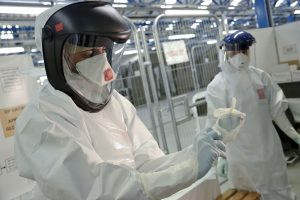The date is June 1941, and the Japanese Empire was preparing to attack the United States to strong arm them out of the Pacific, leaving Japan the sole superpower in the region. The man in charge of putting together the attack was Isoroku Yamamoto, a Harvard-educated Admiral. His efforts resulted in the attack on Pearl Harbor on December 7, 1941, when several Japanese aircraft carriers sailed to the island of Oahu before launching multiple squadrons of planes. Japan ultimately sunk four battleships and killed nearly 2,000 men. It became a race against time for the Japanese as Americans continually encroached further into Japan’s home islands. In 1942, the Japanese Imperial Navy kept losing ground as the U.S. mobilized to enter the war in the Pacific. The Americans had planned to beat the Japanese using their superior manpower and resources, but Japan, being an island nation, was unable to procure large amounts to build battleships and carriers. The Imperial Navy shifted its efforts to building the most technologically advanced ships they could, with hopes to beat the Americans on quality rather than quantity of its naval assets.1

Admiral Yamamoto envisioned the I-400 as a submarine which could hold at least three planes, and that could sail to the United States, Europe, and back. He dreamed that a fleet of them could even sail to the eastern coast of the United States to terrorize Washington D.C. and New York City.2 With the first two of the new class of submarines already seaworthy by 1943, it appeared the program was going on schedule. But then, Yamamoto, the visionary of the program was killed in the Solomon Islands. Combined with the death of Yamamoto, as well as the strained resources being directed to other ships and military equipment, the Japanese Navy’s plans had to be changed, since they were left with only three of the eighteen originally planned, which were known as the I-400, I-401, and I-402.3
Instead of bombing coastal cities, the new mission for the I-400 class was to drop biological weapons on U.S. cities along Hawaii, Alaska, and the U.S. West Coast. Naturally, I-400 class became a prime candidate for spreading fear in the U.S. homeland. Army general Yoshijirō Umezu cancelled this in early 1945, believing a chemical attack on U.S. civilians would be declaring war on humanity.4 The third plan meant to be carried out in Summer 1945 was to sail to the coast of Ecuador, launch the planes, circle around Panama and kamikaze attack the locks from the Atlantic side, where the canal was lightly defended.5
After the landings on Iwo Jima and Okinawa, the Japanese combined command realized the majority of the American forces were already concentrated in the Pacific, and as such, changed their target to Ulithi Atoll, the staging grounds for the American Invasion of Okinawa and Kyushu, the southernmost main islands of Japan. Six planes would be ordered to take out as many aircraft carriers and ships as possible, and the pilots were expected to do Kamikaze attacks. To deepen the element of surprise, they painted the planes in American markings, which was a clear breach of international law. One week before the squadron set sail, the first atomic bomb was used in Hiroshima. Before they could get into position for attack, the Japanese Emperor himself ordered a complete and total surrender to the United States of America.6

On August 28th, U.S. destroyers discovered the I-400s, which had desperately been racing back to Japan. In addition, they had dumped their illicit contraband in the Pacific before attempting a retreat. The Americans were shocked at how massive the subs were, dwarfing anything the U.S. had ever built. Once taken back to Pearl Harbor for further study, the Americans realized that with the oncoming Cold War, if the Soviets ever found out about the I-400s, they could attach nuclear bombs to floatplanes, and strike anywhere in the world. To prevent this, on May 31st, 1946, the I-400 was sunk off the coast of Oahu, the next day, her sister ships would be sunk.7
The secrecy of the project prevented the Allied powers from ever discovering the I-400 project until the end of the war, which was an impressive feat considering that the Americans had cracked both the German and Japanese codes used to communicate with their navies. The advanced technology of the weaponry could have easily been adopted by either the Soviet Union or the United States during the early stages of the Cold War, when the only method of dropping nuclear bombs were using large and visible bombers that needed to be escorted by a squadron of fighters. Had the Japanese Navy procured the materials for the original eighteen ships, perhaps they could have delayed the American advance, or possibly even caused a different outcome had they bombed New York, DC, and Philadelphia. Despite the massive technological and scientific advances made, this class of submarine came too late in the war to change the outcome, and so it became long forgotten under the Hawaiian waves.
- John J. Geogehan, Operation Storm: Japan’s top secret submarines and its plan to change the course of World War II (New York: Crown Publishers, 2013), 30. ↵
- C. Peter Chen, “I-400 Class Submarine,” World War Two Database, 2008, https://ww2db.com/ship_spec.php?ship_id=S451. ↵
- Bob Hackett, 2001,“IJN Submarine I-402: Tabular Record of Movement,“ 2001 http://www.combinedfleet.com/I-402.htm. ↵
- Irwin J. Kappes, “Japan’s Monster Sub,” Military History Online, 2007, https://www.militaryhistoryonline.com/WWII/JapansMonsterSub. ↵
- Larry C. Bowers, “Japanese were planning attack on Panama Canal in the final days of WWII” Cleveland Banner, 2015. http://clevelandbanner.com/stories/japanese-were-planningattack-on-panama-canalin-the-final-days-of-wwii,23600. ↵
- Thomas O. Paine, “The Transpacific Voyage of H.I.J.M.S I-400,” Pacer Farm, 2002, https://www.militaryhistoryonline.com/WWII/JapansMonsterSub. ↵
- Burl Burlingame, “UH Team Locates Huge Japanese Sub,” Honolulu Star, 2005, http://archives.starbulletin.com/2005/03/20/news/story1.html. ↵



47 comments
Bruno Lezama
Good article! I like to read about the weapons used in WWII. I believe that in this era, engineers from the countries in the war created more technological improvements in weapons than in any other era of human history. So, it is common to see weapons with a lot of technology. It is the first time that I heard about this secret I-400 submarine. I find the story of this submarine very interesting.
Mauro Bustamante
The fact that the I-400 as a submarine which could hold at least three planes, and that could sail to the United States, Europe, and back is just amazing. Also the fact that the Japanese weren’t able to use these weapons against the US or other countries really shows notice that history could have gone a different path if they were used. This article was well written and very informative and makes me think of how we have made so much developed technology and weapons as a whole, its kind of frightening of what destructive weapon well be made next? and will it be used at all this time?
D'Hannah Duran
This is a very well written article it is so fascinating how the Japanese were making the I-400, I didn’t even know these weapons had existed. There could be so many differences in the world we know today if the I-400 had actually been used, I am glad that it wasn’t though. I wonder what could have come from furthering the project or what changed would have been made during the creation project.
Mara Martinez
This was a really interesting article. I had never even heard of the I-400 until reading this. But I really don’t know much about any wars as it is. It really is a good thing that the Japanese didn’t ever get the opportunity to use these submarines against the US, as that could’ve lead to a multitude of other issues down the line. To think that these submarines were kept a secret and then had to be destroyed to be kept a secret from the Russians is crazy. The world is kind of messed up in this way.
Sebastian Azcui
This is a very good article! I had no idea about the I-400 and never heard of it. You did a great job explaining what it is and how it was used. The I-400 looks like a very powerful weapon, a weapon that was superior to many back in those times. Japanese did not use it against the US or other countries as their plan failed. How can a project like this, and a weapon this powerful be hidden from others and no one know about its existence.
Jacob Silva
I have always been interested in things that relate to WWII, so this was a really enjoyable read for me. I had never heard about this secret I-400 submarine project, it’s interesting to know that the Japanese were able to keep such a large endeavor a secret from the allied powers. it’s interesting to think about how this new weapon could have shifted the tide of war.
Sabrina Doyon
Wow if this submarine wasn’t stopped by the bombing by the Americans it could have altered history forever. The design of the submarine is crazy and the size was unprecedented compared to the united states. I am almost sad that this amazing creation was hidden away for a long time because this was the first time I have heard of the I-400. This was a great article!
Nicholas Robitille
I had no idea that Japan had the capabilities and thought to build such an amazing vehicle during this time of war. It truly makes things awkward, however, when one compares the refusal of the Japanese to use chemical weapons and the usage of nuclear weapons on Japan. Nevertheless, I found it interesting how the Americans sunk these ships, as they realized the possibility of Russia finding out about them. It is kind of funny how these I-400 submarines had so much potential power, but were never able to be used in the war due to outside influences and the Japanese declaration of surrender on the eve of their unveiling.
Michael Lazcano
It seems that World War II becomes more and more interesting the more you actually dig into it. Before this article I had no idea there was such a submarine capable of so much destruction that the Japanese army possessed in their arsenal. Any form of biological weapon in my opinion should be labeled as a crime against humanity, and the fact that this could’ve landed into more dangerous hands is frightening. This article also makes you think of the other weapons that we don’t know about.
Felipe Macias
Seeing the intentions of other nations during wars put in perspective of the outcomes that have happened to produce the present day. Instead of Japan continuing to terrorize the United States, Japan was shut down when two atomic bombs hit the island. Similar thing with the German military, who wanted supreme reign over Europe but ultimately failed to do so after the Allied forces overpowered their intentions.